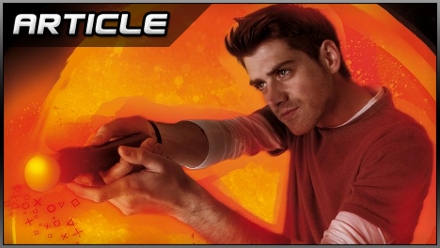
As a piece of hardware that promises to ‘change everything’, attached to a piece of hardware that ‘does everything’, it’s perhaps no more than fitting that PlayStation Move is having a mild identity crisis. Like Nintendo’s Wii MotionPlus, the new ‘high definition’ motion-sensitive controller is an inessential purchase at present for owners of its parent format: only a handful of Move-dedicated PlayStation 3 games have been announced, though more are reportedly in development. Unlike Wii MotionPlus, however, Move is being touted not just as a peripheral but as a ‘platform’, a drastically different proposition in the mind of the consumer, and the gulf between publicity drive and reality may count against Sony in the long run.
PR chatter has been pretty consistent on this point across regions. When the controller was officially unveiled back in March, the UK PlayStation site boasted that ‘the PlayStation Move platform, including the motion controller, navigation controller and PlayStation Eye camera, together with a strong line-up of software titles, will deliver an innovative and highly immersive experience on the PS3 system.’ Last week, Sony Computer Entertainment America’s director of hardware marketing John Koller heaped praise on ‘the world’s first 1:1 motion gaming platform’, echoed a day later by a post on the Sony Computer Entertainment Asia blog.
The rationale behind this choice of words is easy to unpick. PlayStation 3 will be four years old in November, and with recent NPD figures indicative of an industry-wide slowdown the console’s marketeers will be anxious to prove that it has something fresh to offer this year, in the face of an on-going recession and intense competition from similarly pricey techno-luxuries like Apple’s iPad. By referring to Move as a ‘platform’, Sony hopes to create the impression that the controller is both decisively distinct from the Wii remote – a comparison laymen will always be tempted to make, however questionable in terms of blow-for-blow functionality – and also, effectively, an eighth generation console, available years ahead of schedule for a fraction of the price. A nice ‘upsell’ indeed.

Replace Move controller here with cup-and-ball for maximum funniness, possibly.
Microsoft is trying to engineer a similar mentality with Kinect. Speaking to the Financial Post in January (via VG247), the company’s entertainment and devices division president Robbie Bach suggested that the birth of ‘controller-free’ gaming might stand in for the release of a new flotilla of Xbox consoles. ‘The console world has changed fundamentally in a very important way,’ he commented, ‘Innovation doesn’t require new hardware. The fact that we can deliver a new Xbox Live service every year is a very powerful thing and completely changes the experience without changing the console, without requiring the industry to reboot every five years.’ Kinect, Bach believes, will also advance the formula whilst (temporarily) sparing its creators the expense of another graphical arms race.
The trouble for both manufacturers is that the strength of a ‘platform’, whether real or something of an Emperor’s new suit, hinges on the calibre and number of its games, and while Move and Kinect have attracted strong initial support from publishers, it’s quite possible that these peripherals, being in the end only peripherals, will fail to deliver on that investment. In a caustic thought experiment last year I posited that Kinect’s third party support would eventually dry up, as consumers could not be relied upon to own a non-mandatory add-on. Move risks the same fate.
What’s your take on the current Move software line-up, readers?





 Satoru Iwata Video Interview - the late Nintendo president spoke with Kikizo in 2004 as 'Nintendo Revolution' loomed.
Satoru Iwata Video Interview - the late Nintendo president spoke with Kikizo in 2004 as 'Nintendo Revolution' loomed. Kaz Hirai Video Interview - the first of Kikizo's interviews with the man who went on to become global head of Sony.
Kaz Hirai Video Interview - the first of Kikizo's interviews with the man who went on to become global head of Sony. Ed Fries Video Interview - one of Xbox's founders discusses an epic journey from Excel to Xbox.
Ed Fries Video Interview - one of Xbox's founders discusses an epic journey from Excel to Xbox. Yu Suzuki, the Kikizo Interview - we spend time with one of gaming's most revered creators.
Yu Suzuki, the Kikizo Interview - we spend time with one of gaming's most revered creators. Tetris - The Making of an Icon: Alexey Pajitnov and Henk Rogers reveal the fascinating story behind Tetris
Tetris - The Making of an Icon: Alexey Pajitnov and Henk Rogers reveal the fascinating story behind Tetris Rare founders, Chris and Tim Stamper - their only interview? Genuinely 'rare' sit down with founders of the legendary studio.
Rare founders, Chris and Tim Stamper - their only interview? Genuinely 'rare' sit down with founders of the legendary studio. The History of First-Person Shooters - a retrospective, from Maze War to Modern Warfare
The History of First-Person Shooters - a retrospective, from Maze War to Modern Warfare
Does it anoy anyone else that we can’t browse media on the ps3 while music is playing? I used to love slideshowing photo’s and playing tunes when I had friends over, why would sony take that away from us?